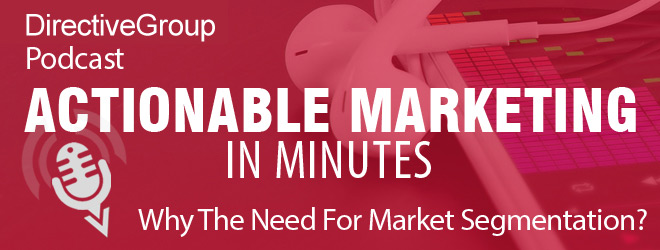In this episode of Actionable Marketing In Minutes we talk about the need for market segmentation in your digital marketing program.
Use the player below to listen to this episode, or the download link to load it on your device for listening later. You can also find our RSS feed by clicking here, or subscribe by email in the sidebar to the left.
Download our Marketing To Millennials eBook here!
Not able to listen? Why not read the episode transcript below:
Problem:
Oh how the times have changed. Once upon a time you used to open a storefront and people would just show up and purchase your goods or services. You didn’t have to worry about advertising, or referrals, or any of these other pesky marketing issues. As others saw the opportunity to fill a need or void, they started opening their own storefronts and suddenly, things changed.
Now your general store had to compete with another general store right down the street! As you would imagine, two stores filling the same void will have a hard time staying in business because their market share is essentially halved. So what do you do in this case? Segment your market and focus your goods and services in a more targeted way.
Solution:
While times have changed, the need to segment your market is stronger than ever! In order to compete in a world where there are 100 businesses doing the exact same thing, you have to be able to segment your market and understand their unique wants and needs. When you understand what users want, you can then develop effective goods and services to cater to these individuals, and do it better than your competition!
There are several ways to segment your market, but common methods are:
Geographic – With geographic segmentation you are looking at variables like the users region, city, state, metropolitan area, population density, climate, etc.
Demographic – For demographic segmentation, you will look at things like age, gender, family size, family income, occupation, education, etc.
Psychographic – Psychographic segmentation looks at lifestyle variables like: activities, interests, opinions, and values.
Behavioristic – Behavioristic segmentation involves the behavior as it relates to products, such as: usage rate, brand loyalty, prioritized features or benefits, readiness to purchase, and special occasions.
Benefits:
Once you are able to properly segment your market and understand common user variables, you have a wealth of new, actionable information at your fingertips! By understanding your market better, you can cater to their specific wants and needs more efficiently. You will be able to be more competitive because you have a unique understanding of the circumstances surrounding a customer purchase, and those customers will likely have more loyalty to your brand because they feel it caters more closely to their needs. And you will be able to message them in a way that resonates, so even your communications will be more on target and more effective.
We hope you’ve found this information useful. Please connect with us on Twitter @DirectiveGroup or on LinkedIn. Let us know what you think and what you’d like to hear about next. And if you like our podcasts please share with your networks using hashtag #actionablemarketing.
Join us for an upcoming episode as we discuss the benefits of social media marketing.
